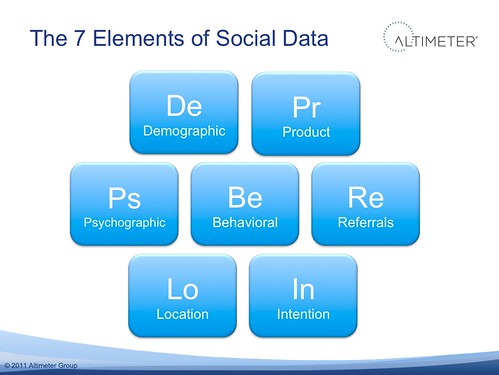Who has more information about US’s Gen Y? Facebook or the United States Government?
Each time I ask this question on stage, most hands vote that Facebook has more information, although someone usually suggests the United States Governmant can obtain it if they need to.
In fact, the amount of consumer data emerging in the social web only continues to hockey stick (see this graphic from Twitter) The following is a summary of a research project we did to understand how to harness new data types in their online experiences.

The 7 Elements of Social Data
We segmented data that has been tried and true for years on the top tier: demographics and product. Then, we segmented data that digital marketers are striving to tackle now in the middle tier: Pschographic, behaviroial, and refferal data. At the bottom tier, we listed out experimental new types of data that most companies have not harnessed, the newcommers location based and intention data.
Demographic Data
This data types enables an effecient way to create context about consumers, yet broad survey-based research may not yield specific nuances and needs about specific individual taste as today’s consumers are given more choices and have more discrete needs. Some marketers are able to glean demographic data from social accounts gender, age range, by profile data, profile pictures, or searching public records like Zabasearch and Spokeo.Product Data
A data type commonly used in ecommerce websites, this data type is used to match similar products with each other, in order to cross-sell and up-sell products. Often combined with demographic data, this data type, mixed with referral and behaviorial data yields greater accuracy. Visit any ecommerce website from Amazon, BestBuy and beyond to find examples of product matching.Psychographic Data
As the social web exploded in the past few years, consumers are volunteraily self-expressing their woes, pains, and aspirations in websites. This provides those who want to reach them increased opportunities to market based on lifestyle, painpoints, beyond just product sets. This data type is useful in both message and conversation creation as well as identifying features and products to improve or fix. To learn more about lifestyle and pain point positioning see the 5 stages of positioning by Lifestyle, Pain, Brand, Product, or Features.Behavioral Data
There’s at least two ways to find this data, it’s in both existing customer records like CRM or ecommerce systems or also in the “digital breadcrumbs” that users are leaving in social networks using a variety of web techniques from cookies, FB connect, and other social sign on technologies. The opportunity to suggest content, media, deals, and products to them that matches their previous behaviors will yield a greater conversion.Referral Data
Customers are emitting their recommendations for products, but positively –and negatively. Both explicitly through ratings and reviews, as well as implcity though gestures like the ‘like’ button to their social network. Vendors like Bazaarvoice (disclosure: client) offer a suite of tools for customer feedback and intelligene, Zuberance fosters positive WOM through positive ratings, and ExpoTV is a catalyst for conversation using video reviews, and see the well known case study from Levi’s who implemented the Facebook Like button.Location Data
As location based technology and services emerge for consumers to emit signals where they are using mobile devices, this data helps to triangulate context around location and time for brands to reach them. From Foursquare checkins and the associated contextual ads that emerge to ‘players’ to Facebook places, consumers can now emit their location, in exchange for contextual information, see how Awareness Hub (client) is able to surface influencers by location in Foursquare Perspectives.Intention Data
The most innacurate, this volatile data type holds great opportunity to predict what consumers will do in the future. Wish lists, social calanders like Facebook Events, Zvents, and aspirational websites like PlanCast, 43 Things allow consumers to broadcast their future plans
Savvy marketers will harness explicit content and serve up the right messages in advance as well as poach from competitors. Learn more about intention data –which is faster than real time.
Conclusion: Use Data Elements in Combination to Yield a more Potent Elixir
In our initial findings we had many other types of data, but organized these in as discrete buckets as possible. While this seven segmentation types makes sense today, we expect many other types of data to emerge just as technology and consumers do. Be sure to use in combination for reaching maximum potency in your ‘data elixir’ –relying on only one is no longer sufficient.
Want to learn more? I did an hour long webinar on this topic, you can watch the replay at NetBase, who hired me to present this original research. Scott attended the webinar, and reviewed the highlights. Thanks to Altimeter’s Christine Tran for help on this project.
Comments are closed.